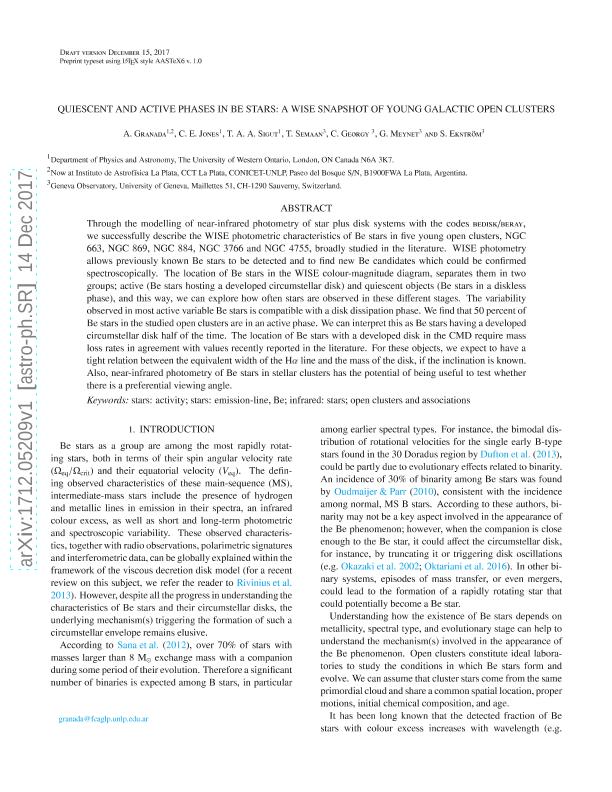Mostrar el registro sencillo del ítem
dc.contributor.author
Granada, Anahi

dc.contributor.author
Jones, C. E.
dc.contributor.author
Sigut, A.
dc.contributor.author
Semaan, T.
dc.contributor.author
Georgy, C.
dc.contributor.author
Meynet, G.
dc.contributor.author
Ekstrom, S.
dc.date.available
2019-08-30T17:37:31Z
dc.date.issued
2018-01
dc.identifier.citation
Granada, Anahi; Jones, C. E.; Sigut, A.; Semaan, T.; Georgy, C.; et al.; Quiescent and active phases in Be stars: a WISE snapshot of Young Galactic Open Clusters; IOP Publishing; Astronomical Journal; 155; 1; 1-2018
dc.identifier.issn
0004-6256
dc.identifier.uri
http://hdl.handle.net/11336/82604
dc.description.abstract
Through the modeling of near-infrared photometry of star-plus disk systems with the codes bedisk/beray, we successfully describe the Wide-Field Infrared Survey Explorer (WISE) photometric characteristics of Be stars in five young open clusters, NGC 663, NGC 869, NGC 884, NGC 3766, and NGC 4755, broadly studied in the literature. WISE photometry allows previously known Be stars to be detected and to find new Be candidates which could be confirmed spectroscopically. The location of Be stars in the WISE color-magnitude diagram, separates them in two groups; active (Be stars hosting a developed circumstellar disk) and quiescent objects (Be stars in a diskless phase), and this way, we can explore how often stars are observed in these different stages. The variability observed in most active variable Be stars is compatible with a disk dissipation phase. We find that 50% of Be stars in the studied open clusters are in an active phase. We can interpret this as Be stars having a developed circumstellar disk one-half of the time. The location of Be stars with a developed disk in the color-magnitude diagram require mass loss rates in agreement with values recently reported in the literature. For these objects, we expect to have a tight relation between the equivalent width of the Hα line and the mass of the disk, if the inclination is known. Also, near-infrared photometry of Be stars in stellar clusters has the potential of being useful to test whether there is a preferential viewing angle.
dc.format
application/pdf
dc.language.iso
eng
dc.publisher
IOP Publishing

dc.rights
info:eu-repo/semantics/openAccess
dc.rights.uri
https://creativecommons.org/licenses/by-nc-sa/2.5/ar/
dc.subject
Stars: Activity
dc.subject
Stars: Emission-Line, Be
dc.subject
Infrared: Stars
dc.subject
Open Clusters And Associations
dc.subject.classification
Astronomía

dc.subject.classification
Ciencias Físicas

dc.subject.classification
CIENCIAS NATURALES Y EXACTAS

dc.title
Quiescent and active phases in Be stars: a WISE snapshot of Young Galactic Open Clusters
dc.type
info:eu-repo/semantics/article
dc.type
info:ar-repo/semantics/artículo
dc.type
info:eu-repo/semantics/publishedVersion
dc.date.updated
2019-08-28T17:58:39Z
dc.journal.volume
155
dc.journal.number
1
dc.journal.pais
Estados Unidos

dc.description.fil
Fil: Granada, Anahi. Consejo Nacional de Investigaciones Científicas y Técnicas. Centro Científico Tecnológico Conicet - La Plata. Instituto de Astrofísica La Plata. Universidad Nacional de La Plata. Facultad de Ciencias Astronómicas y Geofísicas. Instituto de Astrofísica La Plata; Argentina
dc.description.fil
Fil: Jones, C. E.. Western University; Canadá
dc.description.fil
Fil: Sigut, A.. Western University; Canadá
dc.description.fil
Fil: Semaan, T.. Observatoire Astronomique de L Universite de Geneve; Suiza
dc.description.fil
Fil: Georgy, C.. Observatoire Astronomique de L Universite de Geneve; Suiza
dc.description.fil
Fil: Meynet, G.. Observatoire Astronomique de L Universite de Geneve; Suiza
dc.description.fil
Fil: Ekstrom, S.. Observatoire Astronomique de L Universite de Geneve; Suiza
dc.journal.title
Astronomical Journal

dc.relation.alternativeid
info:eu-repo/semantics/altIdentifier/doi/http://dx.doi.org/10.3847/1538-3881/aa9f1d
dc.relation.alternativeid
info:eu-repo/semantics/altIdentifier/url/https://iopscience.iop.org/article/10.3847/1538-3881/aa9f1d/meta
Archivos asociados
